
Alchemy is an ancient branch of natural philosophy, a philosophical and protoscientific tradition that was historically practiced in China, India, the Muslim world, and Europe. In its Western form, alchemy is first attested in a number of pseudepigraphical texts written in Greco-Roman Egypt during the first few centuries AD.
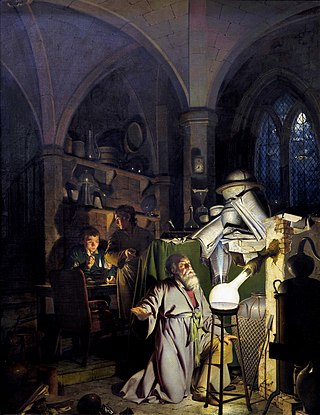
The philosopher's stone, or more properly philosophers' stone, is a mythic alchemical substance capable of turning base metals such as mercury into gold or silver. It is also called the elixir of life, useful for rejuvenation and for achieving immortality; for many centuries, it was the most sought-after goal in alchemy. The philosopher's stone was the central symbol of the mystical terminology of alchemy, symbolizing perfection at its finest, enlightenment, and heavenly bliss. Efforts to discover the philosopher's stone were known as the Magnum Opus.
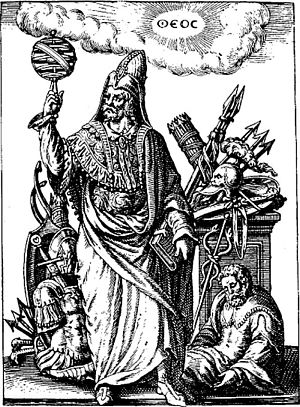
Hermeticism or Hermetism is a philosophical system based on the purported teachings of Hermes Trismegistus. These teachings are contained in the various writings attributed to Hermes, which were produced over a period spanning many centuries and may be very different in content and scope.
Arthur Dee was a physician and alchemist. He became a physician successively to Tsar Michael I of Russia and to King Charles I of England.
A homunculus is a representation of a small human being, originally depicted as small statues made out of clay. Popularized in sixteenth-century alchemy and nineteenth-century fiction, it has historically referred to the creation of a miniature, fully formed human. The concept has roots in preformationism as well as earlier folklore and alchemic traditions.

Michael Sendivogius was a Polish alchemist, philosopher, and medical doctor. A pioneer of chemistry, he developed ways of purification and creation of various acids, metals and other chemical compounds. He discovered that air is not a single substance and contains a life-giving substance—later called oxygen—170 years before Scheele's discovery of the element. He correctly identified this 'food of life' with the gas given off by heating nitre (saltpetre). This substance, the 'central nitre', had a central position in Sendivogius' schema of the universe.

The elixir of life, also known as elixir of immortality, is a potion that supposedly grants the drinker eternal life and/or eternal youth. This elixir was also said to cure all diseases. Alchemists in various ages and cultures sought the means of formulating the elixir.
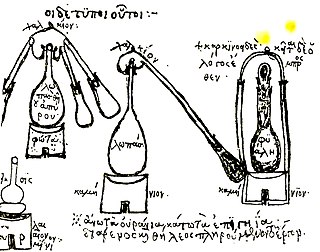
Zosimos of Panopolis was a Greco-Egyptian alchemist and Gnostic mystic who lived at the end of the 3rd and beginning of the 4th century AD. He was born in Panopolis, and flourished ca. 300. He wrote the oldest known books on alchemy, which he called "Cheirokmeta," using the Greek word for "things made by hand." Pieces of this work survive in the original Greek language and in translations into Syriac or Arabic. He is one of about 40 authors represented in a compendium of alchemical writings that was probably put together in Constantinople in the 7th or 8th century AD, copies of which exist in manuscripts in Venice and Paris. Stephen of Alexandria is another.

Heinrich Khunrath, or Dr. Henricus Khunrath as he was also called, was a German physician, hermetic philosopher, and alchemist. Frances Yates considered him to be a link between the philosophy of John Dee and Rosicrucianism. His name, in the spelling "Henricus Künraht" was used as a pseudonym for the 1670 publisher of the Tractatus Theologico-Politicus of Baruch Spinoza.
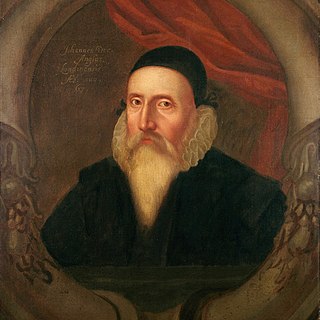
John Dee was an English mathematician, astronomer, astrologer, teacher, occultist, and alchemist. He was the court astronomer for, and advisor to, Elizabeth I, and spent much of his time on alchemy, divination, and Hermetic philosophy. As an antiquarian, he had one of the largest libraries in England at the time. As a political advisor, he advocated the foundation of English colonies in the New World to form a "British Empire", a term he is credited with coining.
The Hermetic Journal was a quarterly journal dedicated to the Hermetic tradition, edited by Adam McLean, and published by Megalithic Research Publications of Edinburgh. The first issue was released in August 1978 and publication continued until 1992.
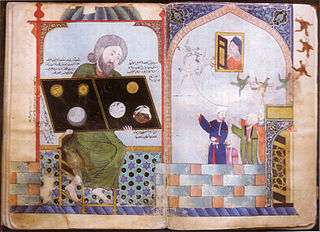
Muḥammad ibn Umayl al-Tamīmī, known in Latin as Senior Zadith, was an early Muslim alchemist who lived from c. 900 to c. 960 AD.

Mary Anne Atwood was an English writer on hermeticism and spiritual alchemy.
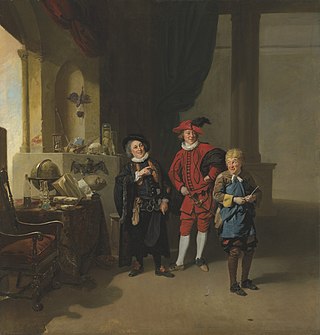
Alchemy has had a long-standing relationship with art, seen both in alchemical texts and in mainstream entertainment. Literary alchemy appears throughout the history of English literature from Shakespeare to modern Fantasy authors. Here, characters or plot structure follow an alchemical magnum opus. In the fourteenth century, Chaucer began a trend of alchemical satire that can still be seen in recent fantasy works like those of Terry Pratchett.

The Mutus Liber, or Mute Book, is a Hermetic philosophical work published in La Rochelle in 1677. It ranks amongst the major books on alchemy in Early Modern literature, just as much as does Atalanta Fugiens by Michael Maier. It has been reprinted numerous times.

Renaissance magic was a resurgence in Hermeticism and Neo-Platonic varieties of the magical arts which arose along with Renaissance humanism in the 15th and 16th centuries CE. These magical arts were divided into seven types.
The Angel of the West Window is a weird fiction novel written in 1927 by Gustav Meyrink steeped in alchemical, hermetic, occult and mystical imagery and ideas interweaving the life of Elizabethan Magus Dr John Dee with that of a fictional modern descendant, Baron Mueller.

Love & Sleep is a 1994 fantasy novel by John Crowley. It is the second novel in Crowley's Ægypt Sequence and a sequel to Crowley's 1987 novel The Solitudes. In it, the protagonist Pierce Moffett continues his book project begun in The Solitudes, exploring especially the relevance of systems of thought, even those magical and supposedly obsolete in writing a non-fiction book about the Renaissance and Hermeticism.

Cleopatra the Alchemist was a Greek alchemist, author, and philosopher. She experimented with practical alchemy but is also credited as one of the four female alchemists who could produce the philosopher's stone. Some writers consider her to be the inventor of the alembic, a distillation apparatus.

Giovanni Mercurio da Correggio was an Italian itinerant preacher, Hermeticist, and alchemist. Due to his bizarre appearance in Rome on Palm Sunday 1484 he has been believed by some scholars to have not actually existed, but this has been contested with other reports that corroborate his eccentricities. His most notable follower was Lodovico Lazzarelli, an Italian humanist poet and alchemist, who writes his accounts of da Correggio in his Epistola Enoch.















